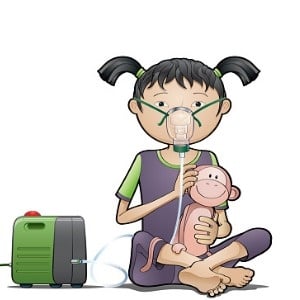
Globally, more than 80 percent of childhood asthma starts before age five. It’s more common in boys and in children who have allergies or come from allergic families. Asthma affects about one in every 10 children.
Diagnosing asthma in infants and toddlers can be difficult as many children wheeze and suffer frequent colds, especially if they go to a crèche or daycare where they continually pick up germs and viruses.
Some children also have naturally smaller airways. This may be a result of inherited factors, smoking by the mother during pregnancy, maternal viral illness during pregnancy or if the child is born prematurely. Research shows that not all children who wheeze go on to develop asthma but, if your child has recurrent bronchitis or a cough especially at night or during the early morning, then be on the alert.
Asthma alert
- Look: if your child gets an anxious look in the eye, draws his shoulders up and you can see the spaces between his ribs, he’s struggling to get enough air.
- Observe: if your child becomes tired within six to 10 minutes of playing, if his playing slows down, if he avoids action sports or complains of a tight chest, there’s a good chance he has asthma.
- Listen: a chronic cough, whistling lungs, shortness of breath and shallow breathing are indications of asthma. In children, a chronic cough is seen as asthma until a doctor says otherwise.
- Be alert: specialists warn that what you might think is the flu or a cold is often asthma.
What to do in an emergency
A moderate or mild asthma attack. Signs:
- Tightness in the chest.
- Coughing up of mucus.
- A feeling of restlessness and trouble sleeping.
- A wheezing or whistling sound when breathing.
He needs two puffs from his reliever (controller medication will not relieve bronchoconstriction during an acute attack).
If two puffs are not enough:
If the asthma symptoms don’t ease within two minutes, the attack is severe, and you must call a doctor. While waiting, or driving your child to the doctor, keep up the reliever therapy. He now needs to use five to 10 puffs in a row. Imagine a huge boa constrictor tightening its grip around the child's chest.
Special warning
In some cases when the attack appears to have eased up, a second wave, which is even more dangerous, can hit. This happens when the airways continue to swell, and this can last for days or even weeks. It can also happen even if there are no asthma symptoms, and can trigger more attacks as the lungs become more sensitive to other irritants.
The second wave often sees patients admitted to hospital and given medicine to reduce the swelling in their air tubes and relax the tightened muscles.
If five to 10 puffs do not work: You need to get to a hospital – but remember to take his pump along and keep giving him five to 10 puffs along the way.
You may also see the following:
- Wheezing (usually loudly) or noisy breathing.
- Breathing fast (more than 30 breaths per minute) or irregular breathing, trying to clear his throat.
- Unable to speak in sentences and trouble talking.
- Anxious look, flared nostrils (with pulse rate higher than 120/min) and neck muscles becoming tight during breathing.
- Spaces between ribs visible when sucking in air (more prominent in a child), skin becoming tight around the ribs, or peak flow having dropped below 60 percent.
- Hunched-over posture.
- Paleness or blue/grey colour around mouth and fingernails, sweating, fatigue.
- At the clinic or hospital, your child will probably receive the following emergency treatment:
Oxygen. - More of the inhaled reliever therapy.
- Inhaled anticholinergic therapy (a strong bronchodilator).
Corticosteroid tablets or an injection.
Remember
1. Know the early warning signs and symptoms.
2. Give a list of these symptoms to friends, family and teachers, together with an action plan and a written set of instructions on what to do in an emergency.
3. Have the telephone numbers of your doctor and the local hospitals handy in the event of an emergency.
4. Severe asthmatics are also advised to have oxygen at hand and to get to the emergency service at the local hospital as quickly as possible.





 Publications
Publications
 Partners
Partners














